Wolf Tooth Waveform
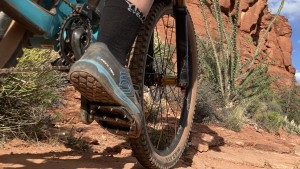 Wolf Tooth Waveform mountain bike flat pedal
Wolf Tooth Waveform mountain bike flat pedal
$200 at REI (before member cash back!)
OVERALL SCORE: 81
- Grip and Traction 9.0
- Platform 8.0
- Mobility 8.0
- Servicing 7.0
- Weight 8.0
Weight per pair: 373 grams | Traction Pins: 11 per side
REASONS TO BUY
Supportive, natural feeling platform
Exceptional grip for confident riding
Lightweight design enhances pedaling efficiency
Interchangeable parts for longevity
REASONS TO AVOID
Premium price point may be a barrier for some
Wolf Tooth Components made a significant entry into the competitive mountain bike flat pedal arena with the release of the Waveform pedals. These pedals have quickly become a favorite among riders and testers alike, earning high marks across various performance metrics. The Waveform’s unique dual concave platform stands out, providing a remarkably natural and intuitive feel underfoot. Our testers consistently praised how “it just feels right,” highlighting the pedal’s exceptional ergonomics. In our rigorous tests, the Waveform excelled in grip, traction, platform stability, rider mobility, and weight. Equipped with 11 bottom-load traction pins per side, these Mountain Bike Flat Pedals deliver outstanding grip across a wide range of footwear, ensuring your feet remain securely planted whether you’re tackling steep climbs or bombing down technical descents. To cater to different rider preferences and foot sizes, the Waveform is available in both small and large platform options. Despite their impressive grip, repositioning your foot on the pedal remains effortless, even when using shoes with sticky rubber soles. The Waveform incorporates three low-friction, fully sealed cartridge bearings, resulting in smooth and predictable rotation, preventing unwanted pedal spin when your foot is momentarily lifted. The pedal’s tapered edges and slightly reduced width are beneficial on challenging, rocky trails, minimizing the occurrence of pedal strikes. Servicing the Waveform pedals is designed to be user-friendly, generally taking about 10 minutes and requiring three Allen keys of varying sizes. A notable advantage is that, unlike many other pedals, bearing replacements can be performed without specialized tools, thanks to Wolf Tooth’s commitment to repairability.
The primary drawback of the Waveform pedal is its higher price. However, this is somewhat mitigated by its full rebuildability. Wolf Tooth offers a comprehensive range of replacement parts through their website, reflecting their “Right to Repair” philosophy. If you’re seeking a top-tier mountain bike flat pedal that can handle everything from cross-country trails to demanding bike park sessions, the Waveform is an excellent choice.
Read more: Wolf Tooth Waveform review
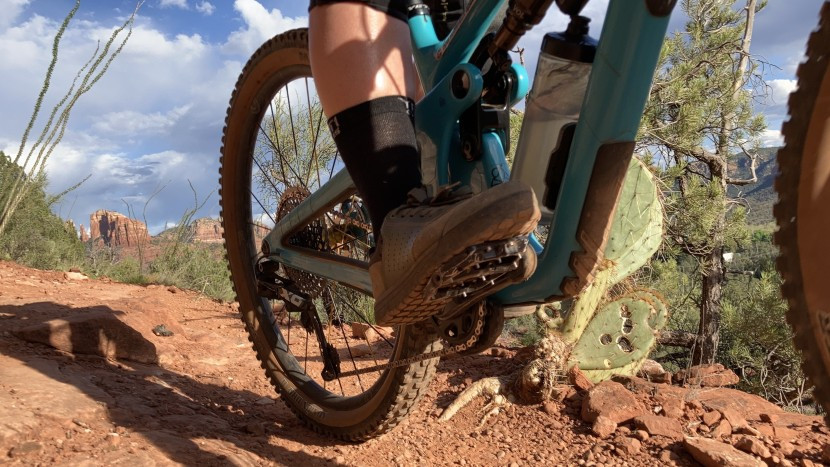 Wolf Tooth Waveform mountain bike flat pedal performing excellently in tests
Wolf Tooth Waveform mountain bike flat pedal performing excellently in tests
The Waveform from Wolf Tooth excelled across the board in our tests.
Credit: Byron Adams
Best Convex Mountain Bike Flat Pedal
Wolf Tooth Ripsaw
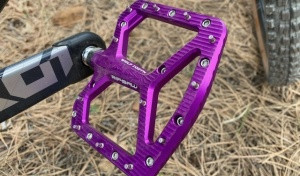 Wolf Tooth Ripsaw mountain bike flat pedal
Wolf Tooth Ripsaw mountain bike flat pedal
OVERALL SCORE: 81
- Grip and Traction 8.0
- Platform 9.0
- Mobility 8.0
- Servicing 8.0
- Weight 7.0
Weight per pair: 381 grams | Traction Pins: 12 per side
REASONS TO BUY
Spacious and supportive platform for enhanced stability
Thin profile for improved ground clearance
Lateral stability optimizes shoe sole contact
Fully rebuildable for extended lifespan
REASONS TO AVOID
Higher price range compared to competitors
The Wolf Tooth Ripsaw mountain bike flat pedals boast a generous 118mm platform that made a strong impression on our testers. Its standout features include exceptional stability, support, and reliable traction, regardless of the rider’s foot size. During testing, we observed that the Ripsaw pedals noticeably reduced foot fatigue compared to other models in our test group. All testers, including those with larger shoe sizes (US men’s size 13), consistently praised the pedal’s remarkable stability. Wolf Tooth has incorporated 12 stainless steel rear-loading traction pins on each side, featuring a robust 3mm head that resists stripping. While these pins may not provide the extreme “grippiness” of downhill-specific pedals equipped with grub screws, they ensured our feet remained firmly planted during landings and while navigating challenging sections filled with roots and rocks. The Ripsaw features a subtly convex aluminum pedal body, measuring 8mm at the leading and trailing edges and 12mm at the axle, based on our digital caliper measurements. None of our testers found the convex shape to be a disadvantage; instead, the shape comfortably conformed to the soles of our feet, irrespective of shoe type. Achieving an optimal foot position required minimal adjustment, and the pedal’s Q-factor felt naturally comfortable. These pedals operate smoothly on three sealed, low-friction bearings, providing an ideal level of drag that prevents unwanted spinning when unweighted. Routine maintenance, such as regreasing the axle and replacing seals, is quick and straightforward, taking less than five minutes per pedal. Wolf Tooth provides clear online written and video instructions, making servicing accessible to home mechanics. Furthermore, a comprehensive selection of replacement parts is available, including pins, bearings, bushings, pedal bodies, and more, ensuring long-term usability.
Despite the Ripsaw’s exceptional performance, its higher price point is worth considering, as it is more expensive than many other pedals in our review. However, the availability of replaceable parts adds value by extending the pedal’s lifespan. Riders should also be aware of the Ripsaw’s 105mm Q-factor, which may be a factor for some. Servicing the Ripsaw requires a deep 18mm socket; standard sockets may not be long enough to access the cartridge, as our testers discovered. For riders seeking a similar convex platform pedal at a more affordable price, we recommend the OneUp Components Composite pedal. This budget-friendly option also features a convex platform but utilizes a nylon pedal body and ten traction screws per side.
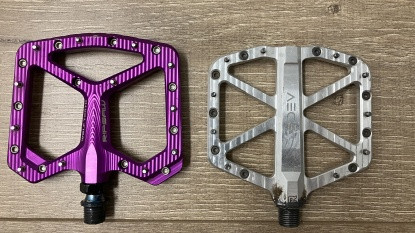 Wolf Tooth Ripsaw mountain bike flat pedal platform and traction pins
Wolf Tooth Ripsaw mountain bike flat pedal platform and traction pins
A 118mm long platform provides loads of support for the foot, while 12 traction pins provide great grip.
Credit: Tara Reddinger-Adams
Best Mountain Bike Flat Pedal for Your Buck
Race Face Chester
OVERALL SCORE: 74
- Grip and Traction 7.0
- Platform 7.0
- Mobility 8.0
- Servicing 7.0
- Weight 8.0
Weight per pair: 358 grams | Traction pins: 8 per side
REASONS TO BUY
Highly affordable mountain bike flat pedals
Tough and durable construction for longevity
Well-proportioned mid-size platform offers versatility
REASONS TO AVOID
Lacks traction pins along the pedal axle
Features only eight pins per side, potentially limiting grip in extreme conditions
The Race Face Chester mountain bike flat pedal stands out as a budget-friendly option that delivers an impressive balance of performance and value. As one of the most affordable models we evaluated, it still achieved commendable scores across all our performance metrics. Weighing in at a mere 358 grams per pair, this lightweight pedal features a robust nylon composite platform. The platform’s dimensions are a moderate 101 mm x 110 mm with a 14 mm profile and incorporates sloped leading edges to minimize pedal strikes. Sixteen replaceable pins per pedal (eight per side) offer a satisfactory level of grip when proper foot placement is maintained. Servicing the internal components is straightforward, and pin replacement is remarkably simple. The Chester pedals also boast a timeless aesthetic and are available in a wide array of colors to match your bike or personal style.
While the Chester pedals are an excellent value, they are not without minor limitations. With only eight pins per side and no pins positioned along the axle, they do not provide the most aggressive grip and can feel somewhat slippery in wet or muddy conditions. The moderately sized platform may also be less ideal for riders with larger feet. However, for riders who prioritize a degree of foot mobility and are mindful of their budget, the Chester remains a compelling choice.
Read more: Race Face Chester review
 Race Face Chester mountain bike flat pedals offering good composite performance
Race Face Chester mountain bike flat pedals offering good composite performance
The Race Face pedals offer good performance for a composite at a reasonable price.
Credit: Al Morrison
Best Budget Mountain Bike Flat Pedal
Fooker Nylon Fiber
 Fooker Nylon Fiber mountain bike flat pedal
Fooker Nylon Fiber mountain bike flat pedal
OVERALL SCORE: 71
- Grip and Traction 7.0
- Platform 6.0
- Mobility 8.0
- Servicing 7.0
- Weight 8.0
Weight per pair: 370 grams | Traction pins: 8 per side
REASONS TO BUY
Provides adequate grip for general riding
Lightweight construction enhances pedaling efficiency
Offers great foot mobility for adjustments
REASONS TO AVOID
Platform may be less suitable for larger feet
Inner component quality may be less refined compared to higher-end pedals
The Fooker Nylon Fiber mountain bike flat pedal surpassed our expectations in performance analysis, especially considering its very affordable price. This pedal achieved above-average scores in grip and traction tests and provides a solid, mid-size platform. At 370 grams per pair, it manages to be lightweight while maintaining reasonable durability. The Fooker pedal utilizes 16 hex-threaded traction pins (eight per side). The concave platform is relatively thin, and we experienced no significant issues with pedal strikes during our testing. A surprising highlight of these pedals is their mobility, attributable to the three sealed bearings inside, which facilitate smooth and easy foot adjustments. Within the budget pedal category, the Fooker pedals stood out as a top performer.
The Fooker pedals share numerous design similarities with the Race Face Chester pedals, appearing to be inspired by their design. In terms of overall performance, these two models are quite comparable. However, upon closer inspection of the internal components, the Fooker pedals exhibit a noticeable difference in finish and quality, particularly concerning the axle and protective cap. Despite these minor shortcomings in component refinement, these pedals offer impressive performance for their price, making them an excellent option for riders operating on a tight budget.
 Fooker Nylon Fiber mountain bike flat pedal with thin profile
Fooker Nylon Fiber mountain bike flat pedal with thin profile
A thin profile and relative concave shape highlight the characteristics of the Fooker Nylon.
Credit: Kenji Mowrey
Best Gravity Mountain Bike Flat Pedal
Deity TMAC
 Deity TMAC mountain bike flat pedal
Deity TMAC mountain bike flat pedal
OVERALL SCORE: 80
- Grip and Traction 9.0
- Platform 8.0
- Mobility 8.0
- Servicing 9.0
- Weight 5.0
Weight per pair: 440 grams | Traction pins: 14 per side
REASONS TO BUY
Large, concave platform for maximum support
Exceptional grip for demanding trails
28 grub screws per pedal (14 per side) for ultimate traction
REASONS TO AVOID
Higher price range compared to some flat pedals
Thick platform may increase pedal strike frequency
Heavier weight than many trail-oriented pedals
The Deity TMAC mountain bike flat pedal is a robust and durable option engineered for aggressive descents and demanding riding conditions. The TMAC was conceived and rigorously tested to meet the exacting standards of Tyler McCaul, a prominent figure in downhill and freeride mountain biking. These pedals represent a harmonious blend of thoughtful engineering and refined aesthetics. Constructed from T6 Aluminum, the symmetrically designed pedals offer exceptional strength and durability. They provide excellent balance, a generous platform size, and abundant grip thanks to the 14 pins per side. Their 2.5mm concave depth enhances both grip and rider comfort during climbs and descents. The symmetrical shape contributes to a balanced feel and promotes even weight distribution across the platform. Riders will find these pedals perform admirably across various riding disciplines, highlighting their versatility.
While we greatly appreciated the TMAC’s remarkable grip, we acknowledge that it might be excessively grippy for some riders. Those who prefer more foot mobility should consider alternative options. Furthermore, the larger symmetrical pedal body and thicker profile of these pedals make them slightly more susceptible to pedal strikes. However, for riders prioritizing a burly pedal with exceptional grip, durability, and distinctive style, the TMAC is a superb choice.
Read more: Deity TMAC review
 Deity TMAC mountain bike flat pedals providing exceptional grip
Deity TMAC mountain bike flat pedals providing exceptional grip
Our feet stayed connected to the TMAC even in the rowdiest terrain.
Credit: Tara Reddinger-Adams
Best Composite Mountain Bike Flat Pedal
OneUp Components Composite
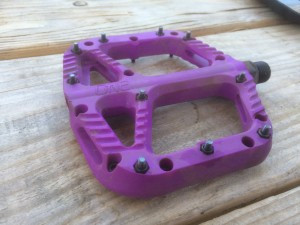 OneUp Components Composite mountain bike flat pedal
OneUp Components Composite mountain bike flat pedal
$50 at REI (before member cash back!)
OVERALL SCORE: 73
- Grip and Traction 6.0
- Platform 7.0
- Mobility 8.0
- Servicing 8.0
- Weight 8.0
Weight per pair: 359 grams | Traction pins: 10 per side
REASONS TO BUY
Excellent value for a composite pedal
Well-rounded performance across various metrics
Easy to rebuild, enhancing longevity
Lightweight design for efficient pedaling
REASONS TO AVOID
Grip level is less aggressive compared to some premium pedals
Slightly thicker platform than some aluminum alternatives
The OneUp Components Composite mountain bike flat pedal is a commendable product that offers impressive performance at a compelling price point. OneUp has successfully delivered a high-quality composite (plastic) pedal incorporating features typically associated with higher-end aluminum models. At first glance, these pedals bear a resemblance to their aluminum counterparts, featuring a relatively large platform and ten bottom-loading traction pins per side. The Composite pedals prove to be highly functional on the trail, consistently performing well in our performance evaluations. They offer a lightweight design that strikes a balance between solid grip and a degree of foot mobility. If you are in the market for a composite pedal that performs reliably and won’t strain your budget, the Composite is an excellent option.
However, it’s important to remember that these are still budget-conscious pedals; their grip and traction capabilities do not quite reach the same levels as some top-tier performers. While they provide adequate grip for most riding scenarios, they don’t match the exceptional grip offered by some of the highest-rated pedals in our review. Nonetheless, they remain a fantastic choice for riders seeking a balance of performance and affordability.
Read more: OneUp Components Composite review
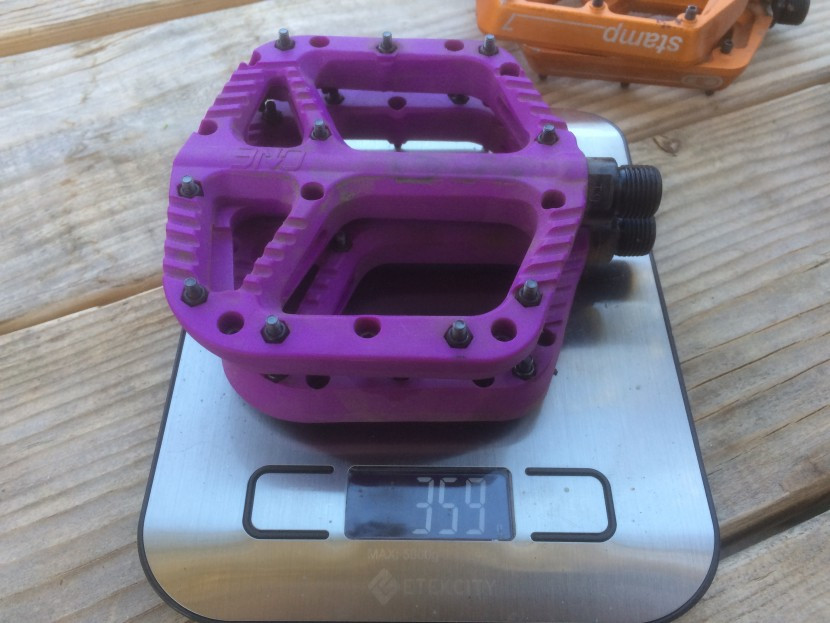 OneUp Components Composite mountain bike flat pedals lightweight and rock-solid
OneUp Components Composite mountain bike flat pedals lightweight and rock-solid
Light, inexpensive, and rock-solid on the trail… whats not to like?
Best Mountain Bike Flat Pedal for Everyday Commuting
CXWXC CX-930 Pedals
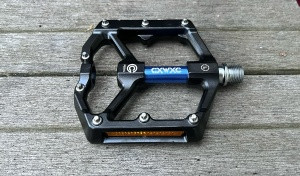 CXWXC CX-930 mountain bike flat pedal
CXWXC CX-930 mountain bike flat pedal
OVERALL SCORE: 66
- Grip and Traction 6.0
- Platform 7.0
- Mobility 6.0
- Servicing 6.0
- Weight 8.0
Weight per pair: 365 grams | Traction pins: 8 per side
REASONS TO BUY
Excellent value for commuting and general use
Solid platform enhances pedaling efficiency
Durable construction for daily use
REASONS TO AVOID
Grip level is inferior to dedicated mountain bike pedals
Platform may be prone to pedal strikes on trails
The CXWXC CX-930 mountain bike flat pedal presents a surprisingly appealing option for riders seeking budget-friendly pedals, particularly for commuting and general use. While its grip is not exceptionally aggressive, the wide concave platform and integrated reflectors make it a worthwhile choice. We evaluated this pedal on both mountain bikes and commuter bikes and found it to be a serviceable flat pedal for trail riding, but ideally suited for full-time commuting, excelling on electric bikes and commuter bikes. The larger platform size provides a rigid base, optimizing power transfer between the rider and the bike. Although traction is not overly aggressive, the hex pins offer sufficient grip to accommodate various shoe types, a practical feature for commuters who may wear different footwear. The CXWXC represents an upgrade over standard factory-equipped pedals and is a suitable option for those needing a larger platform with improved durability and traction for commuting purposes.
It’s important to note that the CXWXC CX-930 Pedals require an 8mm hex Allen key for installation. Unlike many pedals that allow wrench installation, these pedals do not accommodate wrench use. Additionally, the grip level is not on par with comparable entry-level mountain bike flat pedals. The trade-off is a larger platform, integrated reflectors for commuting safety, and the ability to use various shoe types without damaging soles. Despite these minor considerations, the CXWXC pedals offer valuable features for riders needing flat pedals for e-bikes or commuter bikes.
 CXWXC CX-930 mountain bike flat pedal
CXWXC CX-930 mountain bike flat pedal
Testing and measuring the CX-930 pedals.
Credit: Kenji Mowrey
Product Comparison
Each pair of mountain bike flat pedals undergoes testing across diverse terrains and with various shoes to accurately assess real-world performance.
Credit: Byron Adams
Why Trust GearLab for Mountain Bike Flat Pedal Reviews
The pedals you choose can significantly influence your riding experience, and our objective is to assist you in finding the best mountain bike flat pedal tailored to your riding style and budget. Since 2016, we have rigorously tested over 36 different flat pedals, encompassing the latest models on the market, updated versions of past award winners, and established favorites. Annually, we evaluate new pedal releases and select candidates for comprehensive head-to-head testing. Our team of expert testers evaluates each pedal across five key test metrics, specifically assessing grip, stability, mobility, serviceability, and weight. Our testing process commences with precise weight measurements of each pedal pair using a kitchen scale in grams, followed by platform dimension measurements using digital calipers. We then proceed to trail testing, evaluating pedal rotation smoothness, grip performance with diverse shoe types, and platform stability underfoot. Finally, we disassemble each pedal pair to assess serviceability for home mechanics. Each pedal is tested with at least three different shoe brands, two shoe sizes, and is ridden for a minimum of 30 hours in conditions ranging from dry dust to wet and slick trails. Our mountain bike flat pedal scoring is distributed across five rating metrics:
- Grip and Traction (25% of total score weighting)
- Platform (25% weighting)
- Mobility (20% weighting)
- Servicing (15% weighting)
- Weight (15% weighting)
Our test team comprises riders with diverse backgrounds, from freeriders performing backflips to enduro racers, trail enthusiasts, and former racers. This diversity ensures comprehensive pedal evaluation across various riding scenarios. Our review team possesses decades of industry experience encompassing racing, gear testing, and bike shop ownership. The test team is led by Tara Reddinger-Adams, who has over 11 years of bike shop experience and five years as a professional coach and guide. She is joined by Sean Cronin, a BMX racing enthusiast with a passion for two-wheeled adventures; Tasha Thomas, a professional enduro and downhill racer; Al Morrison; Pat Donahue, a former bike shop owner; Annie Clark; and Byron Adams, who also contributed to this review.
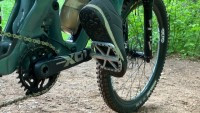 The connection between mountain bike flat pedal and shoe sole
The connection between mountain bike flat pedal and shoe sole
The connection between the pedal and the shoe’s sole is important, and we test each pair of pedals with at least three different models of shoes.
We tested each pair of pedals on smooth and rocky terrain to see how well they gripped our shoes and supported our feet.
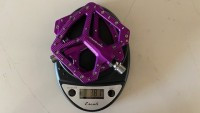 Measuring mountain bike flat pedal weight on a kitchen scale
Measuring mountain bike flat pedal weight on a kitchen scale
Each set of pedals is measured on a kitchen scale to see what the actual weights are compared to the manufacturer’s listed weights.
Analysis and Test Results of Mountain Bike Flat Pedals
Our team of experts evaluated some of the most popular, highly-rated, and latest mountain bike flat pedals to determine the best performing models currently available. Each pedal pair underwent rigorous testing across diverse terrains and conditions, including British Columbia’s coastal rainforests, Minnesota’s plains, California’s mountains, and Arizona’s desert. We gained expertise in pedal swapping, frequently riding with different pedals on each crank arm to discern subtle differences in grip, mobility, and platform stability. Post-ride, we examined each pedal for damage to the pedal body and pins to assess durability. Finally, we serviced each pedal pair to evaluate ease of maintenance for home mechanics. We compiled our findings and experiences across five performance metrics, which, weighted appropriately, determined each pedal’s overall score.
What’s the Best Value Mountain Bike Flat Pedal?
With a vast selection of mountain bike flat pedals available at varying price points, selecting the right option can be challenging. While intricately CNC-machined models are appealing, they often carry a premium price, and more affordable alternatives can frequently deliver comparable performance. Our team tested pedals across a wide price spectrum, from budget-friendly to high-end models, to gain a comprehensive understanding of the mountain bike flat pedal market and identify top value options. We rigorously tested each pedal’s durability to ensure consumers receive excellent value for their investment. While the most expensive models often exhibit peak performance, several reasonably priced options also scored highly for their performance-to-price ratio.
Several pedals stood out in our testing metrics, including offerings from Wolf Tooth Components. The Waveform, with its unique dual concave platform, effectively cradles the foot, providing exceptional grip, traction, and stability. The Ripsaw, featuring a thin convex platform, delivers excellent foot support, stability, and grip. While these pedals are among the more expensive in our review, both are backed by a five-year warranty and are fully rebuildable, allowing replacement of any individual component. The HT Components ANS10 Supreme impressed us with its traction and grip on technical terrain and supportive platform. While its grip and support are slightly less balanced than the Waveform, it offers comparable performance at a considerably lower price, making it a strong value proposition.
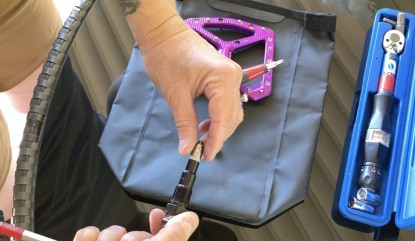 Mountain bike flat pedals with rebuildable parts
Mountain bike flat pedals with rebuildable parts
Some pedals are fully rebuildable with replacement parts ranging from the pedal body to the axle and pins being readily available. Being able to service a pedal extends its life and can prevent you from needing to replace the pedal completely.
Credit: Tara Reddinger-Adams
The budget-conscious OneUp Components Composite also merits recognition for its smooth rolling, supportive convex nylon platform, and good grip at a more affordable price. The Race Face Chester is another budget-friendly model offering good traction and mobility in a slightly smaller platform than the OneUp, making it well-suited for riders with smaller shoe sizes.
 Mountain bike flat pedal platform shape and pins
Mountain bike flat pedal platform shape and pins
The shape of the pedal’s platform and its pins all affect its grip and performance.
Credit: Tara Reddinger-Adams
For those seeking even more budget-friendly options, the Fooker Nylon provides a solid level of grip and mobility, capable of handling technical and steep terrain as well as daily riding. The CXWXC CX-930 also impressed testers with its features at a very accessible price point and is a great choice for commuters. Built-in reflectors on the larger platform enhance safety and provide a worthwhile upgrade over standard factory pedals.
 Budget-oriented mountain bike flat pedals
Budget-oriented mountain bike flat pedals
We also tested pedals where budget comes first, these pedals highlight the group of budget-oriented pedals.
Credit: Kenji Mowrey
Grip and Traction Performance of Mountain Bike Flat Pedals
Maintaining a secure connection between your shoe sole and pedal is crucial for bike control and confident riding. Insufficient connection can lead to foot slippage or bouncing, particularly in wet conditions or challenging terrain. Pedal slippage can disrupt focus, erode confidence, and potentially cause loss of control, crashes, and injuries from pedal pins. In this metric, we assess each pedal’s grip and traction using at least three different shoe models to observe pin interaction with various soles. We tested across diverse trails, from cross-country to enduro, evaluating pin grip during cornering, climbing, technical descents, and high-impact landings and jumps. Some pedals are designed to allow more foot movement than others, which is addressed in our mobility metric.
Most mountain bike flat pedals utilize concave or convex profiles to enhance traction. A concave platform is elevated at the leading and trailing edges, allowing the foot to settle into the pedal body. The Wolf Tooth Waveform excels in this metric, employing a unique dual concave design, creating a cup shape both side-to-side and front-to-back. Testers immediately noted the natural feel and foot-cradling effect of this design, providing optimal traction and balanced grip with 11 pins per side. The Waveform is suitable for daily riding and available in two sizes for optimal shoe fit.
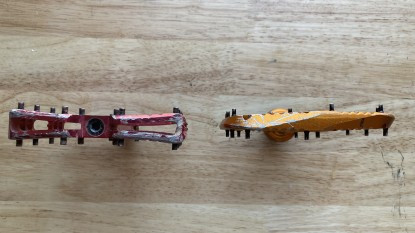 Concave vs convex mountain bike flat pedal platforms
Concave vs convex mountain bike flat pedal platforms
On the left is a concave pedal, and on the right is a convex pedal.
Credit: Tara Reddinger-Adams
The Deity TMAC also scored exceptionally high in grip and traction. The TMAC features significant concavity (2.5mm) and 14 pins per side for maximum grip. This design increases shoe-pedal contact, enhancing grip across all terrains. However, with 14 pins per side, the TMAC offers less mobility and is best suited for high-speed descents where shoe-pedal connection is paramount, making it ideal for gravity-focused riding. The Chromag Dagga is similarly designed for gravity riding, providing tenacious grip that requires intentional foot lifting for adjustments.
 Testing mountain bike flat pedal grip
Testing mountain bike flat pedal grip
Sometimes it’s hard to tell the difference in grip between two pedals, so in these circumstances, we rode with a different pedal on each crank arm.
Credit: Tara Reddinger-Adams
The Race Face Atlas features 10 pins per side, approximately 6mm long, among the longest in our review. These perimeter-positioned pins effectively penetrate soft shoe rubber, generating strong grip. However, be aware that these pins can cause shin and calf injuries if feet slip.
Convex platform pedals are typically taller at the axle, tapering towards the edges, mimicking the foot’s arch. Manufacturers claim this shape enhances shoe-pedal connection as the sole conforms to the platform, increasing traction. The Wolf Tooth Ripsaw, with its slightly convex platform, impressed testers with its secure grip and supportive platform, reducing foot fatigue on long descents. The OneUp Components Composite and OneUp Components Aluminum pedals also utilize a convex shape, but their grip and traction were found to be less aggressive than the Ripsaw.
 Convex platform of Wolf Tooth Ripsaw mountain bike flat pedal
Convex platform of Wolf Tooth Ripsaw mountain bike flat pedal
The convex platform of the Ripsaw, is taller at the axle and narrower at the edges. We found the pedals shape to be comfortable and the pedal to have great grip on all terrain.
Credit: Tara Reddinger-Adams
Mountain Bike Flat Pedal Platform Performance
A pedal platform should provide full foot support without a sensation of sinking into gaps or falling off the edges. The platform should offer a solid foundation regardless of foot position. We evaluate platform performance by measuring dimensions, edge and axle depth, and platform length and width. Ideally, platform dimensions are balanced with thickness. Thicker pedals are more prone to pedal strikes compared to thinner profiles, particularly relevant with modern bike geometries featuring lower bottom brackets.
We analyze pedal shape—concave, convex, or flat. Some pedals use a flat body profile, relying on pin height for shape. Each pedal is tested by riders with varied foot sizes to assess platform support. We compare front-to-back and side-to-side support and note pedal strikes, which can be influenced by pedal width or depth.
 Measuring mountain bike flat pedal platform with calipers
Measuring mountain bike flat pedal platform with calipers
Each pair of pedals is measured with digital calipers.
Credit: Tara Reddinger-Adams
The Wolf Tooth Ripsaw offered the most supportive platform due to its 118mm length, enhancing stability and reducing foot fatigue on long descents by supporting more of the foot. Its thin profile (8.24mm at edge, 12.65mm at axle) and tapered edges minimized pedal strikes. The Race Face Atlas provides impressive grip and a balanced surface area suitable for various foot sizes, with chamfered edges and tapered sides that deflect impacts. The 5Dev All Round features a very thin platform (8mm at edges, 13mm at axle) to reduce strikes. While convex, the All Round’s pin height creates a concave shape.
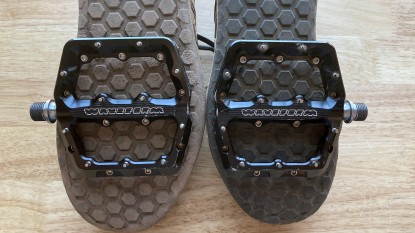 Wolf Tooth Waveform mountain bike flat pedal platform support for different shoe sizes
Wolf Tooth Waveform mountain bike flat pedal platform support for different shoe sizes
A comparison of how much of the sole is supported by a size small Waveform pedal. The shoe on the left is an EU46 and on the right is an EU40. Despite being labeled “small” the pedal provided excellent support for both sized shoes.
Credit: Tara Reddinger-Adams
Some pedals, like the CrankBrothers Stamp 7 and Wolf Tooth Waveform, offer size options for optimal shoe fit. We tested the small Wolf Tooth Waveform and were impressed by its support for both EU40 and EU46 shoe sizes.
Gravity and bike park pedals typically have larger platforms for greater shoe contact. The Deity Components TMAC and Chromag Dagga excel in this area. The Dagga’s platform (111mm x 116mm) provides ample support. The Dagga is also one of the flattest pedals, while the TMAC’s 110mm x 105mm platform with 5mm concavity creates a strong shoe-pedal bond for high-speed riding.
 Wolf Tooth Ripsaw mountain bike flat pedal platform and traction pins
Wolf Tooth Ripsaw mountain bike flat pedal platform and traction pins
Pedal platforms come in different shapes and sizes. The Ripsaw on the left is 118mm long compared to the All Round on the right, which is 110mm. The extra 8mm was noticeable on the trail, especially when riding with a different pedal on each crank and provided more foot stability.
Credit: Tara Reddinger-Adams
Mountain Bike Flat Pedal Mobility Assessment
Pedal mobility refers to foot adjustability on the pedal and pedal rotation smoothness. Some riders prefer firmly planted feet, while others want mobility for adjustments or tricks. Mobility is important for freeriders and dirt jumpers. Rider preference may evolve, but generally, riders desire adjustability without complete foot disengagement. We assess mobility on trails, noting foot repositioning ease and unintended foot movement during impacts or rough terrain, using varied shoe types. We prefer pedals allowing slight foot adjustments without lifting off.
Smooth pedal rotation is crucial, preventing distraction. Overly free-spinning pedals can hinder repositioning after slips. Quality bearings and machining enhance confidence. We evaluate rotation speed and smoothness, noting drag and axle design interference with crank boots. Pedals with predictable rotation and appropriate drag score higher than those that spin excessively freely.
Most tested pedals had desirable rotation speeds – “not too fast or slow.” Repositioning feet on Wolf Tooth Waveform and Ripsaw pedals requires slight unweighting. These pedals rotate smoothly with minimal drag and maintain orientation. Axle design avoids crank boot binding.
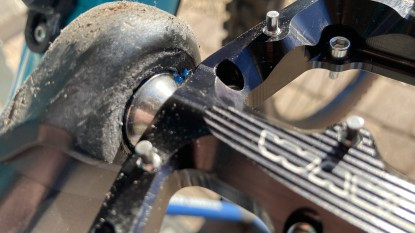 Wolf Tooth Waveform mountain bike flat pedal axle design and bearings
Wolf Tooth Waveform mountain bike flat pedal axle design and bearings
The axle design works well with crank boots and does not bind. In addition, the three cartridge bearings are smooth spinning.
Credit: Tara Reddinger-Adams
The 5Dev All Round Pedal offers smooth rotation and is designed for riders preferring more foot freedom. Testers noted increased foot movement, especially on rough terrain.
 Mountain bike flat pedal foot mobility design
Mountain bike flat pedal foot mobility design
Some pedals are designed to allow more foot movement, and some are designed to have a more locked-in feeling. The All Round is designed to allow more foot movement, which we noticed while riding.
Credit: Tara Reddinger-Adams
The Race Face Atlas has a smooth outboard bearing compatible with crank boots. Foot repositioning is easy, and pin height is adjustable for mobility customization. The HT Components AE03 Evo allows tension adjustment for mobility preference.
We do a basic spin test on each pedal to see how well it spins on its axle and the amount of drag the bearings have.
Credit: Tara Reddinger-Adams
The Fooker Nylon utilizes three sealed bearings, uncommon at its price point, resulting in predictable and smooth rotation. Repositioning is easy, and the pedal maintains position. Conversely, the PNW Loam spins freely, potentially causing instability when repositioning or performing tricks.
 Fooker Nylon mountain bike flat pedal mobility
Fooker Nylon mountain bike flat pedal mobility
The Fookers three sealed bearings provided solid mobility characteristics that pairs well with its reliable traction.
Credit: Kenji Mowrey
Mountain Bike Flat Pedal Servicing Evaluation
Mountain bike flat pedals are generally low-maintenance, but squeaking or chirping indicates regreasing needs, a task most riders can perform at home. Many manufacturers provide online service guides. We evaluate serviceability by disassembling pedals to assess bearing greasing and replacement ease using common tools. Pedals requiring basic tools and offering service guides score highest. We also assess pin removal/installation and replacement part availability.
The redesigned Race Face Atlas scores highly in serviceability, requiring only a 30mm socket and wrench or pliers. The bearing and axle are accessible behind a cap, making it the easiest to service with the right tools.
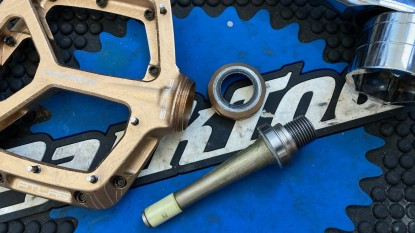 Race Face Atlas mountain bike flat pedal axle removal for servicing
Race Face Atlas mountain bike flat pedal axle removal for servicing
Once the cap is removed the axle of the Atlas pulls away from the body.
Credit: Tara Reddinger-Adams
The OneUp Components Aluminum pedals are also easily serviced, with detailed online instructions. Axle/bearing removal requires few tools. The Wolf Tooth Waveform is relatively easy to service, requiring common tools plus a pick. Wolf Tooth provides a helpful video guide and replacement parts. The Ripsaw is also easily serviced, but necessitates a deep 18mm socket, not listed in the tool list but shown in their video. We found our test Ripsaw pedal needed regreasing after two months of riding.
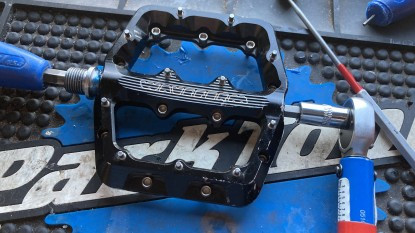 Wolf Tooth Waveform mountain bike flat pedal servicing ease
Wolf Tooth Waveform mountain bike flat pedal servicing ease
Despite needing three different-sized Allen wrenches, servicing these pedals is very easy. Once the axle is removed, you can use it to push the bearings out, eliminating the need for a bearing puller and press.
Credit: Tara Reddinger-Adams
We evaluate serviceability based on experience and available guides. Lack of service guides, like for the 5Dev All Round Pedal, results in lower scores in this metric.
Removal of the Ripsaw axle is quick and easy. Just make sure you have a deep 18mm socket.
Credit: Byron Adams
Mountain Bike Flat Pedal Weight Analysis
While weight isn’t the primary concern for flat pedal riders, a 150-gram weight difference exists among tested pedals, approximately a third of a pound. Racers might prioritize lightweight flat pedals.
Pedal body, pin, axle, and bearing materials influence weight, strength, and durability. Gravity pedals generally weigh more than trail pedals, but pedals are becoming lighter and thinner. We measure weight using a digital scale.
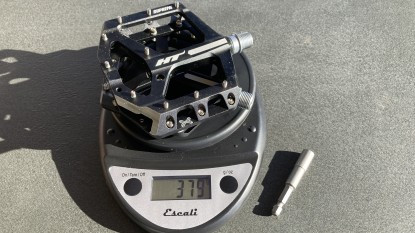 Measuring mountain bike flat pedal weight on digital scale
Measuring mountain bike flat pedal weight on digital scale
Each pair of pedals is measured in grams on a digital scale.
Credit: Tara Reddinger-Adams
The lightest pedals were the HT Components Evo and 5Dev All Round Pedal at 345 grams, followed by the composite Race Face Chester (358 grams) and Puroma Nylon (359 grams). We recommend prioritizing grip and platform over weight when choosing pedals, as these factors impact performance more significantly.
 Mountain bike flat pedal weight measurement comparison
Mountain bike flat pedal weight measurement comparison
Each set of pedals is measured on a kitchen scale, and their weight is recorded. Frequently, there are small differences from manufacturers listed weights.
Credit: Tara Reddinger-Adams
Conclusion: Choosing the Best Mountain Bike Flat Pedals
High-quality mountain bike flat pedals enhance riding enjoyment, boost confidence, and facilitate skill progression. Like grips and saddles, pedals should provide consistent comfort. Avoid selecting pedals solely based on aesthetics or trends without considering riding needs and foot size. Determine your preference for foot mobility and consider typical terrain. For rooty or rocky trails, thinner pedals offer better clearance. Measure shoe sole size and compare it to pedal platform dimensions, ensuring adequate support. Decide if you prefer long-term pedal investment or replaceable options. Pedals with replaceable parts are ideal for long-term value. Our top pedal selections performed best in testing and cater to various price points and riding styles, assisting you in finding the ideal mountain bike flat pedals for your needs and budget. Looking for more bike gear reviews? We test complete bikes and accessories, including mountain bike helmets, mountain bike tires, and a ton more best bike gear categories.
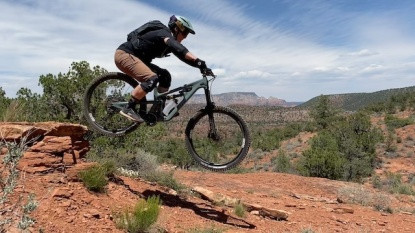 Mountain bike flat pedal testing in challenging terrain
Mountain bike flat pedal testing in challenging terrain
High-impact landings and chunky terrain can test a pedal’s grip and traction.
Credit: Byron Adams

